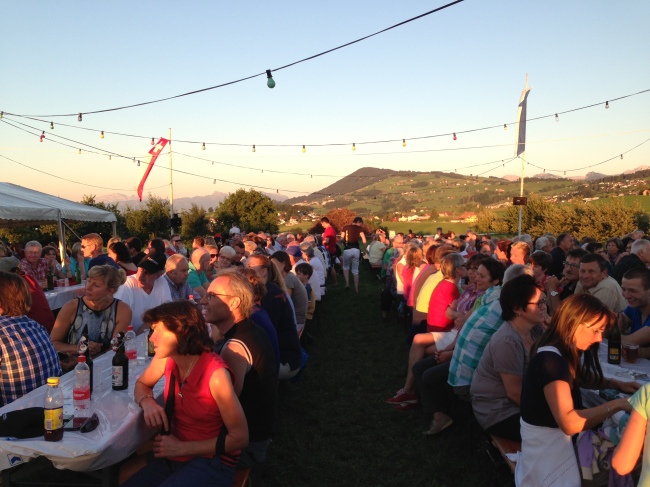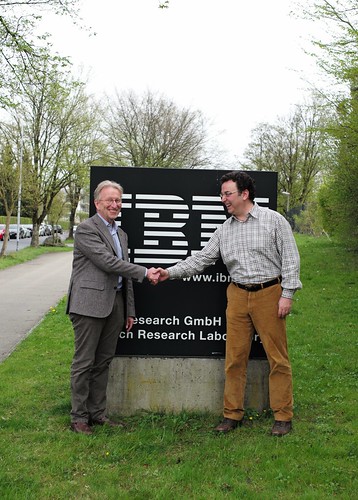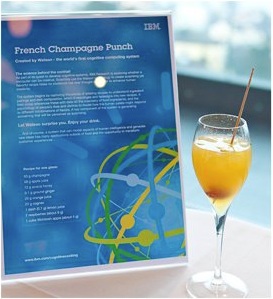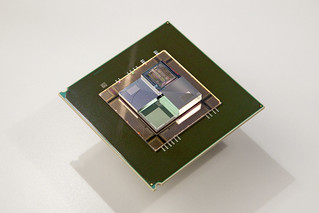Yesterday I had a very special honor. I had been asked in my home village to give a speech on the occasion of our national holiday August 1. This is quite an honor, as I’ve only been a Swiss citizen for some 6 years and usually politicians give the speech.
 It was a fun evening with great fireworks at the end.
It was a fun evening with great fireworks at the end.


For those who speak German, here is the speech:
Vielen Dank für die Einladung, heute an diesem schönen Abend hier in Samstagern die 1. August Rede halten zu dürfen. Ich bin mir der großen Ehre bewußt.
Als ich Freunden von dieser Einladung erzählte, meinten diese, es sei schon sehr außergewöhnlich als Wahlschweizer die Ansprache zur Bundesfeier halten zu dürfen. Nun für alle hier Anwesenden, auch wenn die Sprache noch sehr nach Deutschland klingt, so bin ich doch schon seit etwa 6 Jahren Schweizer und lebe mit meiner Familie schon seit mehr als 25 Jahren hier in Richterswil. Damit kann ich auch mit gutem Gewissen sagen, ich fühle mich als Richterswiler und auch als Schweizer. Ich lebe gerne hier – ich kann mir, die meiste Zeit zumindest, keinen besseren Ort der Welt vorstellen.
Nun aber zum 1. August. Bei unserer Aufnahmeprüfung als Schweizer mussten wir uns ja ein wenig mit der Schweizer Geschichte und dem politischen System auseinandersetzen, um bei der Befragung durch die Einbürgerungskommission unseres Gemeinderates nicht allzu schlecht auszusehen. Glücklicherweise haben sie nach nicht zu vielen historischen Jahreszahlen gefragt. Ich bin ja auch kein Historiker, sondern Informatiker – wir beschäftigen uns weniger mit der Vergangenheit, sondern erfinden die Zukunft.
Ich will damit nicht sagen, daß das eine besser als das andere ist. Aus der Vergangenheit kann man viel für die Zukunft lernen und die neue Informatik hilft sogar bei der Geschichtsforschung und so sind beide Richtungen wichtig.
Und so habe ich mich für den heutigen Abend auch noch mal ein wenig mehr mit der Geschichte unserer Eidgenossenschaft beschäftigt.
Der Grund für unsere Bundesfeier liegt ja ziemlich lang zurück. Anfang August 1291 (1991 haben wir das 700 jährige Bestehen der Eidgenossenschaft gefeiert) wurde der Bundesbrief – ein Verteidigungsabkommen zwischen den drei Talschaften: Schwyz, Uri und Unterwalden unterschrieben und damit ein Anfang für die Eidgenossenschaft gelegt. Wann genau der Anfang wirklich war, darüber streiten sich wohl die Historiker, wurde der 1291 unterschriebene Bundesbrief ja erst im 18. Jahrhundert wiederentdeckt. Bis dahin galt das 1315 geschlossene Bündnis – nach der Schlacht am Morgarten gegen ein Ritterheer des österreichischen Herzog Leopold I – zwischen Uri, Schwyz und Unterwalden als Geburtsstunde der Schweiz.
Worum ging es denn damals in diesen Verteidigungsabkommen und Schlachten? Vermutlich wirtschaftliche Aspekte und Freiheit – wie auch sonst in den meisten Kriegen. Unsere Ureidgenossen wollten sich frei von Vögten und Äbten, denen sie in Hinsicht auf Gerichtsbarkeit, Steuern, Land- und Leibeigentum unterstellt waren, entwickeln können. Sie wollten selbst über ihr Schicksal entscheiden. Es gab damals zwar immer noch die deutschen Könige und Kaiser, aber die freien Landschaften und Städte genossen in vielerlei Hinsicht bereits große Unabhängigkeit und waren in ihrem Tagesgeschäft doch relativ unbehelligt.
Die moderne Schweiz hatte ihren Ursprung sehr viel später. Erst 1803 wurde durch den ersten Konsul Bonaparte den Kantonen eine gemeinsame Verfassung aufgezwungen, in der Napoleon – sehr im Gegensatz zu seinem sehr zentralistischen Entwurf für Frankreich – auf die unterschiedlichen Stände der Schweiz Rücksicht nahm und den Kantonen eigene Verfassungen und ein großes Maß an Autonomie zugestand.
Und so kommen wir zum ersten der zwei interessanten Beobachtungen, ja Dilemmas, die mich an der Schweiz so faszinieren und von denen ich Ihnen heute Abend erzählen möchte.
Das Dilemma zwischen Identität und Weltoffenheit. Wenn wir zurück an die Geschichte denken, dann war das Einigende für die große Schweiz der Druck von aussen und der Wunsch selbstverantwortlich und frei über das Leben und Zusammenleben entscheiden zu dürfen. Wenn wir das Vergrösserungsglas nehmen und in die Schweiz hineinsehen, dann besteht diese jedoch wiederum aus vielen kleinen Einheiten, politisch den Gemeinden, Städten und Kantonen – im privaten aus Korporationen, Verbänden, Vereinen, Parteien, Religionen und Genossenschaften in denen sich jeder einzelne wieder findet. Alle diese Gruppen stiften eine Identität, die uns das wichtige Gefühl der Zugehörigkeit vermittelt. Wir wollen alle irgendwo dazu gehören und identifizieren uns damit.
Bei der Einbürgerung wird ja auch darauf geachtet, in manchen Gemeinden mehr als in anderen, ob die neu einzubürgernden Kandidaten auch dazugehören und sich integriert haben.
Diese Suche nach Identität ist ein urmenschliches Bedürfnis. Wir umgeben uns mit Symbolen, die unsere Identität nach außen signalisieren sollen – so wie die vielen Schweizer Fahnen, die wir heute im ganzen Land sehen; womit wir uns als Volk nach außen zu erkennen geben und unseren Bund feiern.
Die Kehrseite der Identität ist aber auch die Abgrenzung von anderen oder gar deren Ausgrenzung. Diese Abgrenzung kann viele Gründe und Ursachen haben, vielleicht weil man die anderen nicht versteht, sie eine andere Kultur oder Religion haben, eine andere Sprache sprechen. Aber damit haben wir in der Schweiz mit unseren vier Landessprachen und dem Englisch, in dem wir im Zweifelsfall mit unseren welschen Eidgenossen, sprechen, ja kein Problem. Oder weil sie andere Vorstellungen von Demokratie und Zusammenleben haben.
Im konkreten Fall könnten dies z.B. die Autofahrer aus dem Aargau sein. Sie können sich mein Erstaunen denken, als ich kurz nach der Einreise in die Schweiz vor Autofahrern mit diesem Kennzeichen gewarnt wurde. Oder aber die Deutschen, die an der Universität in Zürich vermutete Seilschaften pflegen, um sich gegenseitig zu fördern.
Ziemlicher Unfug, von dieser Seite habe ich die Schweiz und vor allem das Dorf Richterswil nie kennen gelernt. Auch unser Dorf zeichnet sich durch seine Identität aus, es hat einen schönen, gut erhaltenen Dorfkern, man kennt sich noch. Es hat seine Traditionen, denken wir nur an die Räbechilbi – dem größten Räbenumzug der Welt. Gleichzeitig aber ist Richterswil auch weltoffen und heißt auch seine Neuzuzüger, egal woher sie kommen, willkommen und nimmt sie freundlich als Bereicherung auf.
Dieser Spagat zwischen Identität und Weltoffenheit wird hier gut gemeistert. Als ich vor etwa 18 Jahren mal fragte, wie es denn wäre bei der freiwilligen Feuerwehr mitzumachen, wurde mir gesagt, das wäre schon toll, aber dazu wäre es auch gut, wenn ich am Ort arbeiten würde oder wenigstens innert kurzer Zeit zur Verfügung stehen könnte, da ich aber – weil für das IBM Forschungslabor in Rüschlikon arbeitend – immer so viel auch im Ausland unterwegs sei, wäre das vermutlich doch keine so gute Idee.
Diese Weltoffenheit ist das was den Erfolg der Schweiz, so wie ich ihn in den vergangenen 25 Jahren wahrnehmen durfte, ausmacht. So schrieb die NZZ am 16.10.2011 “laut den Ergebnissen der jüngsten Volkszählung lebten Ende Dezember 2010 rund 1’042’000 Schweizerinnen und Schweizer sowie 331’000 Personen mit einem ausländischen Pass im Kanton Zürich. Mit 24,1 Prozent lag der Ausländeranteil damit über dem schweizerischen Mittel von 22,4 Prozent.”
Dies ist schon eine sehr beachtliche Leistung. Wenn man bedenkt, daß das umliegende Europa prozentual sehr viel weniger, z.B. Deutschland lediglich etwa 9%, Ausländer hat.
Wir Schweizer gehen – so glaube ich – mit den Ausländern im Grossen und Ganzen sehr gut um. Auch wenn es immer wieder zu Diskussionen über die vielen Ausländer und die Zuwanderung kommt.
Das war schon immer so:
1956 als das IBM Forschungslabor in der Schweiz gegründet wurde, gab es seitens der Schweizerischen Industrie grössere Vorbehalte, man hatte Angst man würde dem Schweizer Arbeitsmarkt zu viele Kräfte entziehen.
So schrieb 1958, zwei Jahre nachdem das IBM Labor hier in der Schweiz gegründet wurde, der damalige Direktor Ambros Speiser in einem Leserbrief in der NZZ folgendes:
“Es ist unlogisch, wenn gegenüber dem Direktor eines Forschungslabors von gewisser Seite gewünscht wird, er möge keine Schweizer anstellen, um den Arbeitsmarkt zu schonen, während ihm von anderer Seite nahegelegt wird, zur Vermeidung einer Überfremdung keine Ausländer hereinzuholen! Zum Glück sind jedoch die Behörden überaus aufgeschlossen und dank ihrem großen Verständnis und Entgegenkommen konnte bis jetzt immer eine Lösung gefunden werden”.
Einer der Gründe, warum das Labor in der Schweiz und nicht, wie eigentlich für eine amerikanische Firma zu erwarten, in Großbritannien gegründet wurde, war daß die Briten darauf bestanden, wenn es ein solches Labor geben solle, dieses nicht in der Nähe einer Universität, sondern in einer der New Towns lokalisiert sein müsse und daß keine Ausländer angestellt werden dürften, solange es arbeitslose Briten gäbe.
Derartige Vorbehalte gab es von offizieller Seite in der Schweiz nicht. Man erklärte den Amerikanern zwar, daß man ein Schweizerisches Labor, das Schweizer anstelle, vorziehe es aber keine Regeln gegen ein ausländisches Labor und ausländische Mitarbeiter gäbe.
Nun, ich bin froh darüber, daß es wegen dieser Weltoffenheit damals zu einem Standortentscheid für die Schweiz kam, war das doch der Grund für meinen beruflichen und privaten Umzug hierher.
Neben der Weltoffenheit, ist aber auch unser Streben nach Identität ein entscheidender Wettbewerbsvorteil. Die vielen Vereine, Verbände und freiwilligen Organisationen nehmen eine enorm wichtige Rolle in unserem Gemeinwesen ein. Wir übernehmen selbst die Verantwortung und zeigen nicht auf andere, die dies tun sollten. In meiner Erfahrung identifizieren wir Schweizer uns mit dem Staat und leisten unzählige Stunden an Milizarbeit für unser Wohlergehen.
Durch unsere direkte Demokratie können wir nie auf jemanden anderen deuten, der für etwas verantwortlich ist, das wir nicht tun wollen. Es kommt immer wieder auf uns zurück. Wir sind selbst verantwortlich und – was wirklich wichtig ist – übernehmen auch diese Verantwortung.
In meiner Erinnerung an Deutschland ist dies dort anders. In Deutschland ist der Bürger für den Staat da, die Politik wird von professionellen Politikern gemacht, die vielfach anders motiviert sind, als unsere Politiker, die selbst als Nationalräte dieses Amt häufig nur neben ihrem eigentlichen Beruf wahrnehmen. Hier sind wir der Staat und er ist für uns da.
Das zweite Dilemma, von dem ich sprechen möchte, ich das Dilemma zwischen Veränderung und Tradition.
Es liegt in der menschlichen Natur Traditionen zu bewahren. Wir halten an den Dingen fest, die uns erfolgreich gemacht haben.
Veränderungen hingegen, sind immer mit neuen Unwägbarkeiten verbunden und führen zu Verunsicherung und Ablehnung.
Wenn ich an 1992 zurückdenke, als es um den Beitritt der Schweiz zum EWR ging, war dies so ein Dilemma – von der Wirtschaft, Bundesrat und Parlament wurde dies als eine wichtige und notwendige Öffnung der Schweiz gegenüber dem europäischen Umland hervorgehoben. Das Volk – und dort vor allem die Stände – entschied anders. Die Opposition wollte den Status quo bewahren und den Alleingang fortsetzen, der die Schweiz seit so langem erfolgreich gemacht hatte. Die Gegner sprachen davon, daß man mit bilateralen Verträgen sich die Vorteile des EWR, eines vertieften Wirtschaftraumes, zu Eigen machen könnte ohne aber die Nachteile eines Souveränitätsverlustes hinnehmen zu müssen.
Tatsächlich haben wir uns in den mehr als 20 Jahren nach dieser Abstimmung verändert und nunmehr, sehr viel langsamer als mit den 1991 verhandelten EWR Verträgen, so ziemlich dasselbe Ergebnis erzielt, wie es mit einem EWR Beitritt entstanden wäre. Interessanterweise kamen einige dieser Verträge vor das Volk zur Abstimmung und wurden mit großen Mehrheiten angenommen. So z.B. die Weiterführung der Personenfreizügigkeit und die Ausdehnung derselben auf Rumänien und Bulgarien 2009, die mit knapp 60% Volksmehr und 19.5 Ständen angenommen wurde.
Dieser Umgang mit Traditionen und Veränderungen ist eine außergewöhnliche Qualität unseres Landes. Wir brauchen für Veränderungen häufig etwas länger, weil wir alle gesellschaftlichen Gruppen darin mit einbeziehen und ihre Meinungen dazu hören und versuchen darauf einzugehen. So dauerte es für den Entscheid den Gotthard Basistunnels zu bauen 45 Jahre von den ersten Ideen 1947 bis zum NEAT Entscheid 1992. Bis zur Eröffnung werden nochmals 3 Jahre vergehen.
Andererseits bedeutet diese langsamen Entscheidungsprozesse jedoch auch, daß wenn man mal entschieden hat, alle dahinter stehen und man das Vorhaben dann relativ zügig ohne weitere Einsprüche umsetzen kann. Wenn ich an deutsche Eisenbahnprojekte – siehe den Umbau des Bahnhofs in Stuttgart – denke, dann wird zwar schnell entschieden, danach aber endlos diskutiert und demonstriert, was zu sehr viel mehr Unsicherheiten führt.
Diese Eigenschaft des langsamen Entscheidens und das Konzept der Vernehmlassung wird im Ausland häufig als Unwillen zur Veränderung verstanden – wenn man allerdings einmal damit vertraut ist, weiß man, daß man damit Veränderungen nachhaltig bewirken kann.
Damit will ich zum Ende meiner Rede kommen. Ich denke, ich habe beobachtet, daß wir uns in der Schweiz mit verschiedensten Dilemmas auf eine ganz eigene Weise – vielleicht unbewußt für viele – auseinandersetzen und daraus immer wieder Vorteile für uns ziehen. Sei es das Streben nach Identität bei gleichzeitiger Weltoffenheit oder dem Bewahren von Traditionen mit der Fähigkeit Veränderungen nachhaltig umzusetzen.
Ich bin glücklich darüber hier leben zu dürfen und als Wahlschweizer beitragen zu dürfen.











 In a nutshell, it is like the title says or more specifically, don’t complain and consider yourself a victim, but rather take ownership of the situation and realize that if you take over responsibility you also have the power to change it.
In a nutshell, it is like the title says or more specifically, don’t complain and consider yourself a victim, but rather take ownership of the situation and realize that if you take over responsibility you also have the power to change it.
 To briefly summarize, it was a very interesting experience. The organizers had selected 18 female candidates and no males for this workshop. In my opinion this was a very clever choice. When I look at our technical leaders (who can reach the executive ranks with science-friendly titles including
To briefly summarize, it was a very interesting experience. The organizers had selected 18 female candidates and no males for this workshop. In my opinion this was a very clever choice. When I look at our technical leaders (who can reach the executive ranks with science-friendly titles including 




